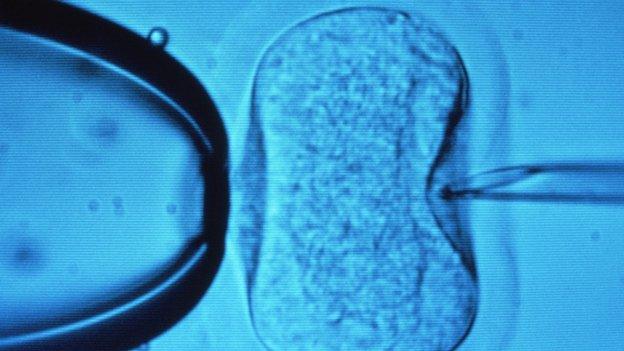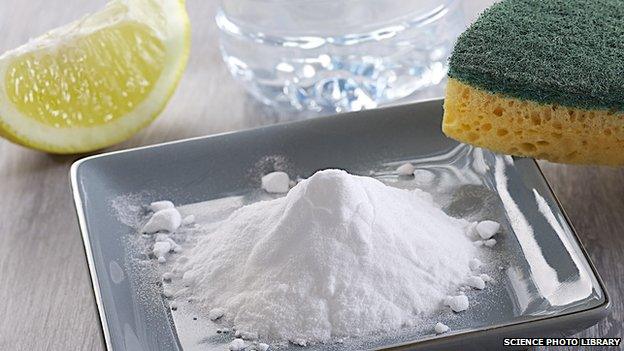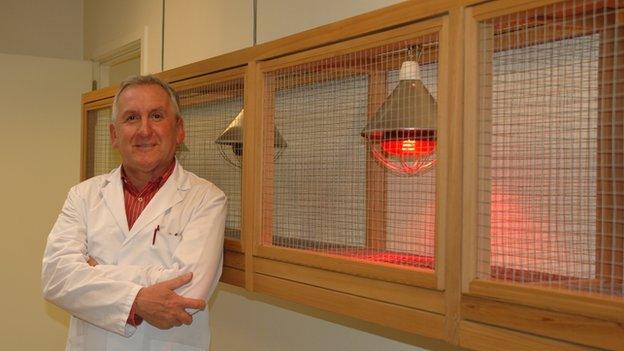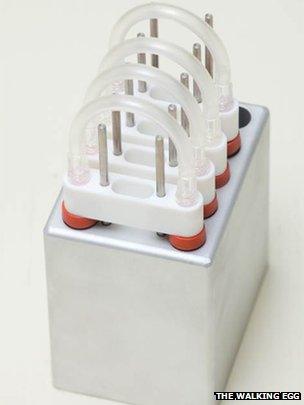'Shoebox IVF' hope for infertile couples
- Published

Traditional IVF can prove too expensive for many
Could an IVF kit that fits in a shoebox and some kitchen cupboard essentials provide hope for people who long for children?
Infertility is a source of distress the world over, but in many places the terrible stigma attached to childlessness makes it even harder to bear.
The answer could be a pared-down system that can fit inside a shoebox and uses cheap ingredients you might find in a kitchen cupboard.
In the past infertility has been neglected in developing countries, partly because of a focus on controlling overpopulation.
But experts argue that true reproductive health has to address both sides: family planning for those who want to avoid pregnancy, and fertility treatment for those who long to have children but can't conceive naturally.
Nosiphiwo, from South Africa, had been trying to conceive for years when her husband's family asked her for their lobola back - the bride price they paid when she married their son.
She was ostracised by her in-laws for being childless, and felt cut her off from the rest of her community too. She says women in her situation sometimes turn to suicide.
"I thought of doing that. Because you don't have any option."
Sophisticated labs
The prohibitive costs of fertility treatment mean that worldwide, most couples cannot afford it - though their desperation can be such that many become destitute trying to pay for it, selling property or going into debt.
One of the biggest obstacles is the cost of the complex, sophisticated labs where "in vitro" egg fertilisation takes place.

The carbon dioxide needed to create the right conditions for the embryo was made using baking soda and citric acid
Belgian obstetrician Dr Willem Ombelet worked in South Africa in the 1980s and saw many cases like Nosiphiwo's.
He carried out IVF treatment for those who could afford it. Those who couldn't came to the hospital on other pretexts - but the real reason was their longing for a child.
"They would wait shyly around the corner and ask if there was anything we could do for them."
Back then, the heartbreaking answer was no.
But he has campaigned ever since to improve global access to infertility care, co-founding The Walking Egg non-profit organisation to raise awareness of fertility in developing countries.
DIY embryo transport

Willem Ombelet teamed up with artist Koen Vanmechelen to raise awareness of infertility in developing countries
The centrepiece of the Walking Egg's mission is a simplified system for egg fertilisation.
The best conditions for a sperm to fertilise an egg outside the body are slightly alkaline, at a temperature of 37C (98F).
Usually this involves a sophisticated laboratory equipped with huge ventilators, complex incubators and a supply of expensive gases.
But when Dr Ombelet met the embryologist Jonathan Van Blerkom in 2008 the idea of a cheap, portable lab was born.
Van Blerkom revived a technique he used in the 1980s when transporting cow embryos long distances across Nebraska.
By mixing baking soda and citric acid he created his own CO2, periodically adding it to the solution holding the embryos to maintain the optimal CO2 concentration and alkalinity levels.
IVF in a shoebox
For humans the technique had to be refined to create a closed system and thus minimise any risk of contamination.

The test tubes are held inside an aluminium heating block
Precise quantities of citric acid and sodium bicarbonate are mixed in one test tube. The CO2 bubbles this creates are fed via a tube into a second test tube containing a culture medium for the embryo.
To maintain the perfect temperature for egg fertilisation and embryo development, Van Blerkom tried out various low-tech methods.
"I put the test tubes into a thermos at the right temperature - that worked. I put them in an aluminium heating block, and that worked too. The embryos didn't care if they were in an expensive triple walled incubator or a thermos flask."
Once the atmosphere has stabilised, the egg and then the sperm are injected into the test tube containing the culture medium.
The next day this test tube goes under a microscope to see if it contains an embryo - meaning egg fertilisation has taken place.
If a successful embryo is created, it is transferred from the test tube to the woman's womb after about six days.
This simplified system reduces the whole IVF lab to an aluminium heating block containing one pair of test tubes for each embryo, all inside a shoebox-sized container.

The whole system would be housed in a self-contained incubator in places without access to sterile labs
For additional safety the human trials of the system have so far been conducted inside a sterile laboratory.
The team are developing a self-contained unit to house the system in hospitals or health centres that don't have advanced lab facilities. This would provide heated, sterile air and space to examine the embryo under a microscope.
The researchers believe that - because of the closed nature of their system - this unit is not strictly necessary, but will help convince health authorities of the quality of the system.
"Embryo quality"
Trials began in Genk, Belgium in 2012, and so far 17 healthy babies have been born using the system.
Dr Ombelet is thrilled with their preliminary results, saying they indicate fertilization and pregnancy rates are similar to expensive IVF methods.
"We have proved that with our system embryo quality is at least as good as with regular IVF."
Geoffrey Trew, a consultant in reproductive medicine and surgery at Hammersmith Hospital in London who is not connected with the research, agrees this is an exciting technique.
"It has been shown to work in a developed country. Now we've got to see how well it is reproduced in the developing world where the conditions are more fickle."
Fertility on a shoestring
The trials are due to be rolled out in South Africa and the UK later this year, and the team hope that by early next year the system can be tested in the kind of low-resource settings it was designed for.
Each IVF cycle costs less than 200 euros (£159) using this system, not including staff and medication costs, which vary from country to country.
But Dr Ombelet says they can decrease the normal price for IVF in any given country by at least 70-80%.
"With very low dose medication schemes we hope to perform IVF in developing countries for less than 500 euros (£399)"
Prof Thinus Kruger and Dr Matseseng are fertility experts from Tygerberg Hospital in Cape Town.
They already have a special fertility programme that cuts costs by economising on medication and staffing - Nosiphiwo was one of the many women who was helped to conceive by this programme.
Fertility on a shoestring
Now they want to see how the tWE system compares to their normal laboratory procedure.
"It's really theoretically amazing," says Professor Kruger.
"But we will have to see how patient and scientist friendly this system is. It is a little lab, so you still need the knowledge to handle those small embryos."
Prof Van Blerkom believes that efforts to bring the cost of fertility treatment down would please the IVF pioneer Robert Edwards, whose work led to the birth of the first test tube baby, Louise Brown.
"People can make fortunes through IVF. But Bob Edwards was a real believer that IVF should be universal, because he knew the suffering that infertility caused."
Listen to The Truth about Life and Death: Fertility on a Shoestring on the BBC World Service on Wednesday 25th June 1932 GMT.